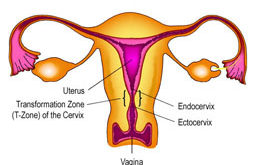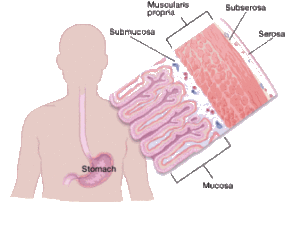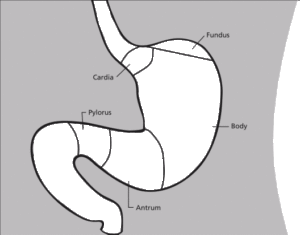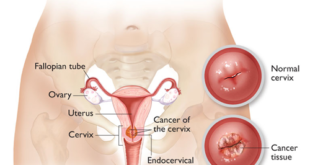Stomach cancer, also called gastric cancer, is a cancer that starts in the stomach. To understand stomach cancer, it helps to know about the normal structure and function of the stomach.
The stomach
After food is chewed and swallowed, it enters the esophagus, a tube that carries food through the neck and chest to the stomach. The esophagus joins the stomach at the gastroesophageal (GE) junction, which is just beneath the diaphragm (the thin sheet of breathing muscle under the lungs). The stomach is a sac-like organ that holds food and starts to digest it by secreting gastric juice. The food and gastric juice are mixed and then emptied into the first part of the small intestine called the duodenum.
Some people use the word stomach to refer to the area of the body between the chest and the pelvic area. The medical term for this area is the abdomen. For instance, some people with pain in this area would say they have a “stomachache,” when in fact the pain could be coming from the appendix, small intestine, colon (large intestine), or other organs in the area. Doctors would call this symptom abdominal pain, because the stomach is only one of many organs in the abdomen.
Stomach cancer should not be confused with other cancers that can occur in the abdomen, like cancer of the colon (large intestine), liver, pancreas, or small intestine because these cancers may have different symptoms, different outlooks, and different treatments.
Parts of the stomach
The stomach has 5 parts:
- Cardia: The first portion (closest to the esophagus)
- Fundus: The upper part of the stomach next to the cardia.
- Body (corpus): The main part of the stomach, between the upper and lower parts
- Antrum: The lower portion (near the intestine), where the food is mixed with gastric juice
- Pylorus: The last part of the stomach, which acts as a valve to control emptying of the stomach contents into the small intestine.
The first 3 parts of the stomach (cardia, fundus, and body) are sometimes called the proximal stomach. Some cells in these parts of the stomach make acid and pepsin (a digestive enzyme), the parts of the gastric juice that help digest food. They also make a protein called intrinsic factor, which the body needs to absorb vitamin B12.
The lower 2 parts (antrum and pylorus) are called the distal stomach. The stomach has 2 curves, which form its inner and outer borders. They are called the lesser curvature and greater curvature, respectively.
Other organs next to the stomach include the colon, liver, spleen, small intestine, and pancreas.
The stomach wall has 5 layers:

- The innermost layer is the mucosa. This is where stomach acid and digestive enzymes are made. Most stomach cancers start in this layer.
- Next is a supporting layer called the submucosa.
- Outside of this is the muscularis propria, a thick layer of muscle that moves and mixes the stomach contents.
- The outer 2 layers, the subserosa and the outermost serosa, wrap the stomach.
The layers are important in determining the stage (extent) of the cancer and in helping to determine a person’s prognosis (outlook). As a cancer grows from the mucosa into deeper layers, the stage becomes more advanced and the prognosis is not as good.
Development of stomach cancer
Stomach cancers tend to develop slowly over many years. Before a true cancer develops, pre-cancerous changes often occur in the inner lining (mucosa) of the stomach. These early changes rarely cause symptoms and therefore often go undetected.
Cancers starting in different sections of the stomach may cause different symptoms and tend to have different outcomes. The cancer’s location can also affect the treatment options. For example, cancers that start at the GE junction are staged and treated the same as cancers of the esophagus. A cancer that starts in the cardia of the stomach but then grows into the GE junction is also staged and treated like a cancer of the esophagus.
Stomach cancers can spread (metastasize) in different ways. They can grow through the wall of the stomach and invade nearby organs. They can also spread to the lymph vessels and nearby lymph nodes. Lymph nodes are bean-sized structures that help fight infections. The stomach has a very rich network of lymph vessels and nodes. As the stomach cancer becomes more advanced, it can travel through the bloodstream and spread to organs such as the liver, lungs, and bones. If cancer has spread to the lymph nodes or to other organs, the patient’s outlook is not as good.
Types of stomach cancers
Different types of stomach cancer include:
Adenocarcinoma
About 90% to 95% of cancers of the stomach are adenocarcinomas. When the term stomach cancer or gastric cancer is used, it almost always refers to an adenocarcinoma. These cancers develop from the cells that form the innermost lining of the stomach (known as the mucosa).
Lymphoma
These are cancers of the immune system tissue that are sometimes found in the wall of the stomach. About 4% of stomach cancers are lymphomas. The treatment and outlook depend on the type of lymphoma. For more detailed information, see Non-Hodgkin Lymphoma.
Gastrointestinal stromal tumor (GIST)
These are rare tumors that start in very early forms of cells in the wall of the stomach called interstitial cells of Cajal. Some of these tumors are non-cancerous (benign); others are cancerous. Although GISTs can be found anywhere in the digestive tract, most are found in the stomach. For more information, see Gastrointestinal Stromal Tumor (GIST).
Carcinoid tumor
These are tumors that start in hormone-making cells of the stomach. Most of these tumors do not spread to other organs. About 3% of stomach cancers are carcinoid tumors. These tumors are discussed in more detail in Gastrointestinal Carcinoid Tumors.
Other cancers
Other types of cancer, such as squamous cell carcinoma, small cell carcinoma, and leiomyosarcoma, can also start in the stomach, but these cancers are very rare.
 Female Cancer Specialist Doctor in Kanpur female, doctor, cancer, specialist, female, oncologist, oncology, medical, oncologist, chemotherapy, breast, blood, mammography, prostate, center, hospital, radiotherapy, surgery, mouth, kanpur, sn, memorial, female, doctor, cancer, specialist,
Female Cancer Specialist Doctor in Kanpur female, doctor, cancer, specialist, female, oncologist, oncology, medical, oncologist, chemotherapy, breast, blood, mammography, prostate, center, hospital, radiotherapy, surgery, mouth, kanpur, sn, memorial, female, doctor, cancer, specialist,





